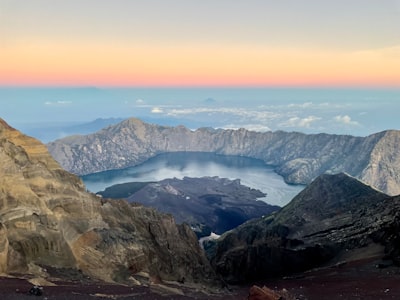Mount Rinjani is an active stratovolcano located on the island of Lombok in Indonesia. At an elevation of 3,726 meters (12,224 feet), it is the second highest volcano in Indonesia, after Mount Kerinci on Sumatra. The volcano and its surrounding area are encompassed within the Gunung Rinjani National Park, a popular destination for trekking, scientific research, and ecotourism.
Geography and Features
Mount Rinjani dominates the northern half of Lombok and is known for its large caldera, which is approximately 6 km by 8.5 km in size. Within the caldera lies Segara Anak, a picturesque crater lake, and the active volcanic cone, Gunung Barujari, which has emerged from the lake. The landscape around Rinjani features steep slopes, savanna, forest, and a variety of ecosystems.
Volcanic Activity
Mount Rinjani is considered highly active, with eruptions recorded as recently as the 21st century. Volcanic activity includes explosive eruptions and lava flows from Barujari. Scientists frequently monitor Rinjani to forecast eruptions and mitigate risks to both locals and visitors.
Trekking and Tourism
The mountain is renowned for its challenging treks, particularly the multi-day hikes to the summit and around the caldera. The main trekking routes begin from the villages of Senaru and Sembalun. Climbing Mount Rinjani is physically demanding due to rapid elevation gain, variable weather, and rugged terrain. Annually, thousands of trekkers, both domestic and international, attempt to reach the summit and visit Segara Anak. Safety, preparedness, and proper acclimatization are strongly advised due to incidents related to altitude sickness, falls, and sudden weather changes.
Cultural and Spiritual Significance
Rinjani holds spiritual importance for the local Sasak and Balinese populations. Ceremonies and pilgrimages to Segara Anak are performed regularly, often as part of annual religious observances. These rituals are believed to appease the spirits of the mountain and ensure the well-being of local communities.
Conservation
Gunung Rinjani National Park was established in 1997 to conserve the unique flora and fauna associated with the volcano and to manage tourism sustainably. Local authorities collaborate with international conservation organizations to protect endangered species and support community-based tourism, aiming to minimize environmental impact.
Natural Hazards and Preparedness
Hiking Mount Rinjani presents significant risks, including landslides, sudden weather changes, hypothermia, dehydration, and potential volcanic activity. Rescue operations have been conducted in the past involving both local authorities and search-and-rescue teams. Visitors are encouraged to prepare thoroughly and follow guidelines provided by park management.

Comments
No comments yet. Be the first to comment!